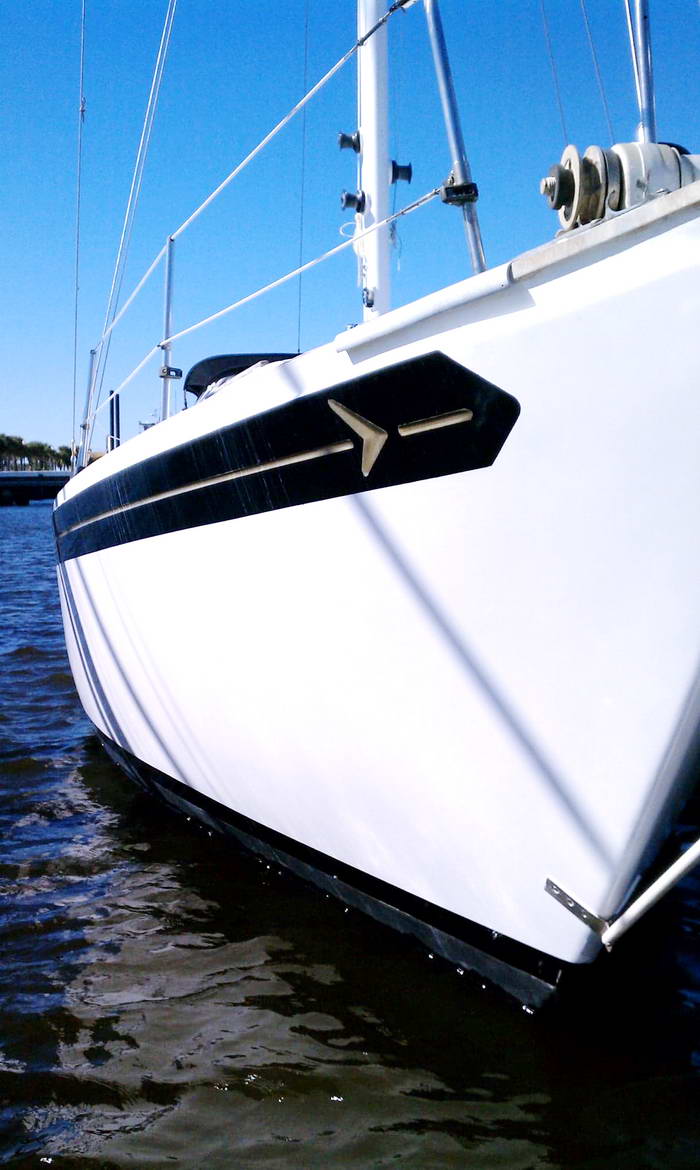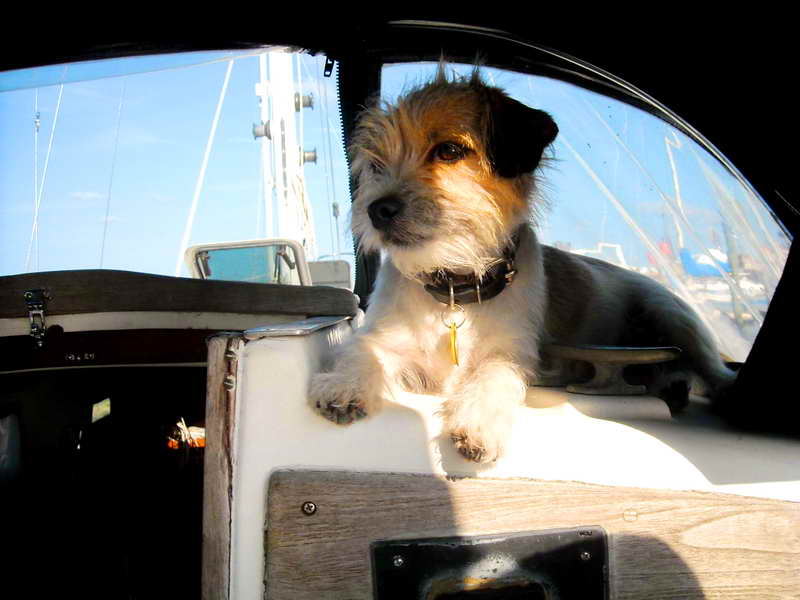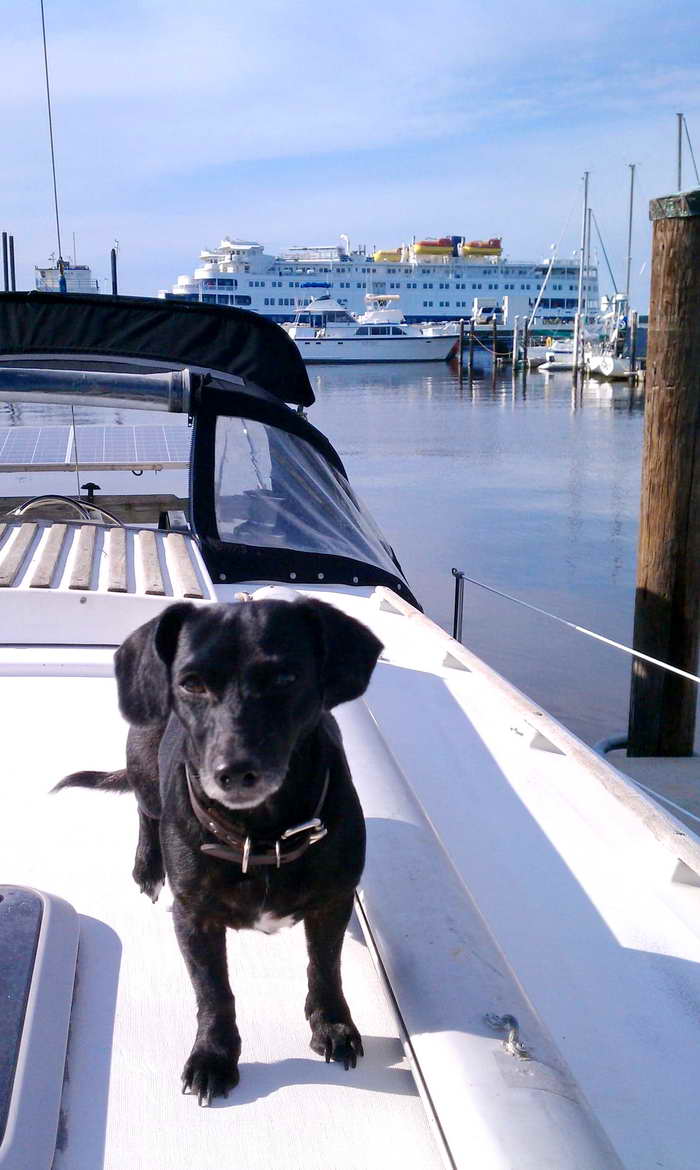Being In Your Mid-Twenties and Living on a Boat has Its Rewards, But It Takes Work.
Spend any time close to a large body of water and you are likely to find a marina somewhere along the shore. Strolling along the walkways and docks, gleaming white hulls bob and bounce on the water. Tall masts punctuate the skyline in an aluminum forest leafed with booms, rigging, and flags. The water gurgles as it bubbles under the dock footings and laps against the seawall. Birds wheel in the strikingly blue sky, riding the currents of the breeze that cools your skin from the heat of the sun.
On a few of the boats, people are milling around. These are big boats, large enough to spend the night on, or cruise along for days. Their owners and guests are casually dressed in shorts and light shirts. Sandals on their feet signal that they are looking forward to another casual day on the water, enjoying each other’s company and the fruits of their labor.
The larger the boat, the greater the costs in insurance, maintenance, and marina fees, not to mention the purchase price. Boating, at this scale, is normally for the well off and retired. This brings into focus just how cool of a story it is that by her mid-twenties Natalie spent two years in Florida living on a boat that she had bought, and fixed up.
When asked, most people can point to at least a few moments in their childhood that played a part in shaping who they would become. Human nature is partially built around experiences that become etched in our memories. These experiences may not be connected in any defined way, and yet they combine together at opportune times and create ideas and impulses that drive us to try new things or even make wholesale life changes.
Natalie is no different. Born in Canada, her family moved to Florida near Ft. Myers when she was very young, to pursue professional opportunities. Along the way, the family picked up a sailboat, unknowingly laying a foundation that Natalie would build on years later. She recalls, “We had a little sailboat, a 25 footer. We would go out a lot after school, on the weekends. Me and my brother and my dad and uncle, and other members of the family, they would come and we would all go out. My mom would [go out] occasionally. She didn’t like to go fast or when the boat leaned over.”
Natalie’s early childhood memories are filled with unique experiences that only being out on the water could create. “We’d go out after school, just into the bay even,” she says. “ And there would be, as far as you can see, tiny jellyfish in the water.” These creatures didn’t keep her from joining them, and she would swim off the boat. Today she gets asked about that a lot. “People were like ‘Didn’t you ever get stung?’ This is the first year, actually, I ever got stung by a jellyfish. And I have swam hundreds of times with so many jellyfish!”
Digging back into her memories she also recounts, “I remember falling asleep in the sails on the bow coming in after a full day of sailing. I loved everything about it, really.” As these images come back to her, she laughs and jumps into a story from when she was six about an exciting and memorable overnight trip to a cabin on an island.
“I remember this one time we were going out to this island called Cayo Costa. I remember there were sea urchins and all sorts of cool stuff out there on the island. There was a ferry that would take you out there if you didn’t have your own boat. There’s lots of walking trails and little cabins out there on the island. We sailed out there and there was a storm that came in and my mom and my brother decided they didn’t want to take the sailboat back because of the storm.
“We weren’t in the storm yet, but the storm was coming. So they took the ferry back and me and my dad and my uncle took the sailboat. The winds were picking up, and my dad and my uncle were playing chicken. You know, on a sailboat, you have ropes that hold the sails taut? So they were playing chicken on who would let go first as the boat was leaned all the way over where the water was coming up over the side. I was like, ‘Yes, this is the best thing ever!’”
Now to Horses and Determination
The family move to north-central Florida came when Natalie was eight. Even though she had to give up her life near and on the ocean, living in the middle of the state did come with a bonus on her 10th birthday. “Because I’m a little girl, I wanted a horse. I wanted a horse and I wanted a dog, just like any little girl does. My mom always said, ‘When we have land we’ll get a dog and a horse.’ We bought land, and we built a brand new house on it. As soon as we moved into that place they were like, ‘Ok, here’s a horse. Here’s a dog!’
“He was a rescue horse. He was a purebred Morgan. He was a fancy show-horse, but he was 16 when I got him. His name was Rosalyn’s Nobility and he had so many fancy awards that he had won. We just called him Billy.” The family though, at the time, was more accustomed to sailboats than horses. No one knew how to ride, and Natalie hadn’t had lessons. Natalie just climbed on and was looking forward to her first ride on her horse. It did not go well.
“I didn’t know how to ride at all,” Natalie says. “The very first time I ever rode this horse I fell off and broke my face!” She chuckles a little as she recalls this incident, but as she talks about it, it becomes clear that it wasn’t funny. She got badly hurt, chipping her teeth, and injuring her face.
Natalie was undeterred. “Here I was, this little girl, who has got herself a horse, and I’m too scared to ride him because I fell off him and got hurt real bad. So, I would tie him up in the corner of the fence (which I had built, by the way). I’d just climb up the fence and sit on him and then I’d just slip off. I’d go off the left side, right side, go over the butt, over the shoulders, until I was really comfortable sliding off a horse and landing on my feet.
“And then I wasn’t really scared at that point anymore. So this took some time, getting comfortable around the horse, getting on, and getting off. Eventually, I untied him and I just rode him in a halter and a lead rope. He would walk around the fields and I would do the same thing: I’d slide off the side, slide off the other side, over the shoulder, over the butt. The horse was very patient with me! I didn’t even have a saddle in the beginning. This horse taught me how to ride. “
Conquering fear is something that would serve Natalie well over the years. Even at this young age, she would make a conscious choice to do things that, at the time, were scary, in order to rid herself of the feeling of fear. “I think what I was always scared of the most was being afraid. I hated that feeling.
“I remember when I was little I was scared of the woods and the dark. And where the horse was set up was way out in the woods. There was a path I would take that would go from the garage and it was pitch black out there. I would make myself wait ‘til full dark to feed the horses, just to force myself. I just didn’t like the feeling of being scared. I was like, ‘Well that’s stupid, why be scared of the dark? Fine, I’ll just feed the horse every day in the dark until I get over it.’ Maybe it was a boredom thing – we didn’t have tv growing up at all,” Natalie concludes with a laugh.
Her love of horses and determination to ride were noticed by those in her neighborhood. From about ten years old until she graduated from college, Natalie spent her time being employed by her neighbors and tending their horses. She developed a reputation for not being afraid of their horses, even the expensive ones. She was often asked to ride them in competitions and condition them for endurance rides. Upon graduation from college, Natalie believed it was time to open her own business.
She was able to lease a property and began to board and train horses. That led, eventually, to the purchasing of her own property. The property she chose had a barn that was exactly suited to her needs, but the property itself needed a lot of work. Natalie put up fences, built a house, and did everything needed to make this business successful. She gained clients, hired employees, and generally thrived in her business venture. There was just one problem: the business consumed her whole life.
Natalie sums up the experience in this way, “ I ended up with this horse farm, put all my money into it and my time. For the longest time, I didn’t really have a life because that was my everything. I lived there, and I ended up with a lot of business and a lot of connections. I would buy hay in bulk and people from other farms would come there and buy it. I also met a lot of crazy horse people. I don’t know if you know this about horse people, but they are all nuts!
“There was a three-month stretch where the only place I went to was the feed store. I think I just really burned out hard.” Her social circle was extremely limited. “There were the horse people, my employees (I had hired people at that point to help with stalls and turnouts and all this other stuff). Mostly the people who had horses there–those were the only people I hung with.” In her mid-twenties, with a successful business under her belt but with very little time for socializing or getting away from her work, the end came abruptly.
Natalie says, “ I just crashed real hard. Crashed and burned.”
From a Horse Farm to Living on a Boat
Like a switch being thrown, she knew she needed a change, a new path – at least for a little while. “I put up signs all over, down the road and stuff, that said ‘Barn Sale Saturday and Sunday’. Then every weekend I sold–and sold and sold. It took me 6 weeks of hard sales just to put a good enough dent in it, all the crap I had accumulated–just the tools and the saddles, everything. So much stuff that I had accumulated. It wasn’t difficult at all,” Natalie says of closing the business. “Everything needs to go!’ I gave away the horses! I gave them away.”
The abrupt ending of this chapter in her life didn’t come without a plan. The sea was calling her back. The allure of nights spent under the stars, followed by days of blue skies and even bluer water. Natalie wasn’t about to drop out and become a drifter; she had a plan. It would not be easy. Her dream was living on a boat, but boats were expensive. In order to make her move to the ocean, she would need to find a boat that was in need of repair, and then do the hard work herself. The payoff would come later: once the work was done, she would be able to live a leisurely life aboard her sailboat.
Natalie remembers, “I didn’t really know what I wanted in a boat. I knew I wanted something I could live on, that wasn’t going to be too expensive. I wasn’t going to take a mortgage out for a boat–which you can do, by the way, if you live on it.
She’d decided on a Seafarer, which had seen production in the late 70s. The 38-foot boat she found came with all the space needed to live on it. It had a full kitchen, bathroom, cabin space, and even a shower. “You can cross the ocean if you want,” she says as if this is a normal thing to do. “The only one I could find for sale is up on land… in the middle of Alabama! I had to hire a crane and a semi to go in and get it.
“Anyway, there’s a lot of things wrong with the boat, but it was so cheap. I think I paid six Grand, $6,300, something like that. It was so cheap that I didn’t even care. I basically got it for nothing. I think I paid $1500 bucks total for the semi and the crane. The boat finally arrived at the marina near Jacksonville, Florida where she had decided to live. It was not yet seaworthy, so the Seafarer was set up on land where she could live and work on it.
Natalie went to work rehabilitating the boat, making mistakes but learning along the way. “I worked on it and worked on it. I sanded and painted the entire thing, which took a long time because the first time I put the paint on– I did it too thick. I didn’t thin it out properly, so I had to sand it all off and do it again.
“The whole mast had to be redone. I had to do an entirely new bowsprit because it had cracked. There was some damage along the very top of the hull, like along the rails and to the fiberglass. So I learned how to repair fiberglass. It was a lot of work. I had to rewire everything!”
Natalie seems particularly proud of having solved an alternator problem on the boat. Laughing again, she recounts, “There was a Perkins diesel engine and it was in a compartment in the bottom of the boat. So to work on it at all you had to hang upside down into this little compartment. The alternator was toast and you can’t just buy a 1977 Perkins alternator. So, me and the guys there at the shop at the marina rummaged through a bunch of old diesel engine parts and found something that might work. They were like ‘Well, let’s just see if this works’, and they put two different alternators together and it WORKED!”
There is a lesson here in how to treat people. It didn’t hurt that Natalie was willing to work hard to get her boat in shape.
“I had the guys at the dock,” she elaborates. “They were very helpful with anything I didn’t know. I always asked a lot of questions. I never pretended to know anything. I still, to this day– I’ll point to a part of the boat and call it “the thingamajigger” or something because I don’t know the name of it! Everybody was very helpful. They kind of took me under their wing and showed me a lot of stuff. They never charged me for this crazy amount of knowledge.” Being humble and thankful went a long way for her, with many question and answer sessions ending with, “Thank you, do you want to come sailing with me later? Want to hang out? I’ll buy you a beer!”
“Eventually we put the boat in the water. That was a big day, they did it on my birthday which was awesome! I was like ‘IT FLOATS!'” Floating was good, but the refurbished sailboat still wasn’t ready to go anywhere, and neither was its owner. There was more work to be done but now, actually living in the boat on the water, things had a different feel.
Natalie relaxed a little more and allowed herself to live a lot more – more than she had done in her years of owning and training horses. The guys at the marina gave her an AC unit to put on the boat, to make living and working onboard more comfortable. She took up running, partied a bit, and had a good time. “I was young,” she said. “I felt like I was free for the first time in my life.” For the first time, Natalie had no one, people or animals, dependent on her apart from “these two little dogs that you can carry around in your backpack.”
Still, living on a boat but tied to the docks wasn’t enough. The freedom of the ocean called to Natalie, and she now had to learn how to sail. With some help, Natalie first learned how to undock the boat, and then bring it back in to dock again. It was important that she could maneuver the boat around the docks without damaging anything. The next step was learning how to actually sail her boat so that she could take it out on her own.
Natalie proudly relates, “I learned. I got comfortable with tacking. There are these systems you can buy so you can sail on your own. I got all the lines rigged up so that they went back to the cockpit. I just got everything figured out on my own. How to pull the sails in, how to tack, and everything.” Out on the water, she found a nice surprise. “The boat already had an autopilot. I assumed it would not work.” Being an old boat, it was a given that a lot of things on it would not function. The memory of discovering equipment that still operated rings with happiness when she recounts her reaction: “I’m like, ‘Sweet, it works!’”
A working boat meant a more sedate life cruising up and down Florida’s Atlantic Coast. Her first trip out was a relatively short sail down to St. Augustine. As Natalie grew more confident, she eventually ranged further, ending up just north of Miami. She recalls that she, “went all the way down to Pompano Beach, anchored out there, swam in!”
This is a fond memory for her, and the laughter returns to her voice. “I anchored out at Pompano Beach this one time and swam to the beach.” Walking from the beach, she went “in my bikini into this Sushi restaurant that was right there on the beach. Walked in, sat down, and ate sushi. I made friends with the owner of the place. He made me sushi right in front of me. I ended up going back there hundreds of times. It was interesting–all the people, this community of weird… Drifters,” her voice trails off, lost in the memory.
Living on a boat isn’t all sunshine and fair weather. Natalie says, “When there is a hurricane and you own a boat, you have two options. Most people go with the first option which is to have the marina pull your boat out of the water. You can’t leave the boat at the docks. It will destroy the boat, it will destroy the docks. Or option B– you take it out into the bay and ride it out. I did that, because that was fun and it didn’t cost anything!”
To Natalie, this wasn’t as risky and daredevil as it sounds. In fact, it was a pretty safe option, she points out, although the waves could still get intense. “As long as you have good anchors and you know where the wind is and you anchor your bow into the wind [it’s safe]. I would always use 3 anchors. It would hold the boat going into the wind. And it really wasn’t that bad. I wasn’t out on the ocean or anything. If you weren’t used to it, it would finish you. They [the waves] got pretty big. A couple of times you could feel the anchor really pull the bow down. Maybe 10-12 foot swells at some point.”
With a nice nest egg to support her, Natalie was in control of her life. She had earlier taken part-time work at a local hospital to pay a few bills and stretch out her savings. “I had ‘prn status’ at work. When I landed, if I needed money, I would work some shifts.” She also figured out that she could share her lifestyle with others, even if for only short times, and it would help pay the bills, too.
“Eventually, I got bored. You know, a little bored, a little out of money. Probably spending too much money on rum, as you do; as a sailor. It’s kind of required. So I went and got my captain’s license. And then I went to my insurance company and paid a little bit extra for the boat so I could take people out and charge money. It started out as afternoon trips. I didn’t advertise or anything. It was all just word of mouth. Three or four times I had a couple come out and I would take them out five days. Down the coast and back up. That’s how I made extra money.
“I wasn’t charging even a quarter of what normal sailboat charters charge. I wasn’t anything fancy. Just me and my old boat. I didn’t charge very much. So the people were always, like, ‘This is awesome!’”
Thus it was that Natalie spent a couple of years in her mid-twenties as a captain, owner, and sailor on the Atlantic ocean. Just as other chapters in her life ended, this one did, too. She hadn’t seen much of her extended Canadian family in years, so she decided to drive north and visit her relatives. It was there, in Montreal, that the boating life came to an end.
Natalie is matter of fact, remembering the change. “I drove around and stayed with family. I hung out with cousins I hadn’t seen in forever. I ended up in Montreal, at the end, with my cousin, Bruce. I enjoyed my time in Montreal so much. There’s a mountain in the middle of the city! It just blew my mind. I left my car parked the whole time and just walked. I’d take the metro. I’d just hold the dogs or put them in a bag. Off we went, and we’d climb up the mountains. I don’t know, it was so different and interesting. I was like, ‘I’m going to move here for a little while.’ So I moved back to Canada.”
That was it. No feeling of being burned out. No conscious uncoupling from the life she lived in Florida. Just simply a mountain, a return to her roots, and new adventures. Eventually, Natalie sold the boat and made her move to Canada permanent. For a while, she worked with horses again and has brought a couple of her horses back from Florida. Now, she is on to the next adventure, as a truck driver bringing new cars to dealerships. It might seem a random jump, but not to Natalie.
It’s just another chapter. The couple of years she spent living on a boat was a needed change from her time on land with the horses and her own business. The move back to Canada, similarly, made good sense, too. “I’m very good at adapting to new situations,” Natalie says. “Anywhere I go, it’s very easy for me to slip into a new role, and I enjoy new things. I think I learned a lot with that first bit, the horse farm, about letting go. Where I am or what things I have, have a lot of weight.” Like the horse farm, like the sailboat, like all that came before, her now is good. It’s all she needs.
All photos Courtesy of Natalie
Interview conducted on November 7, 2020











♥️♥️♥️
You did such an amazing job telling my story!! Thank you!!